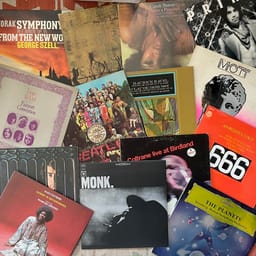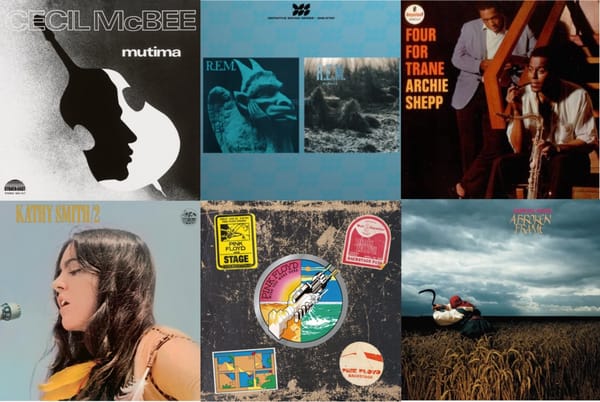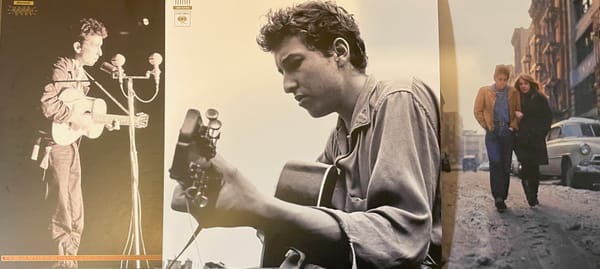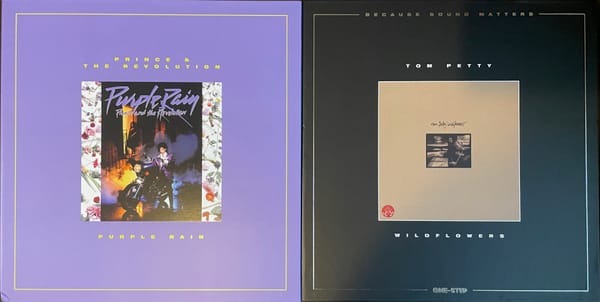Rhino Rocktober: The Doors, Morphine, and Yes
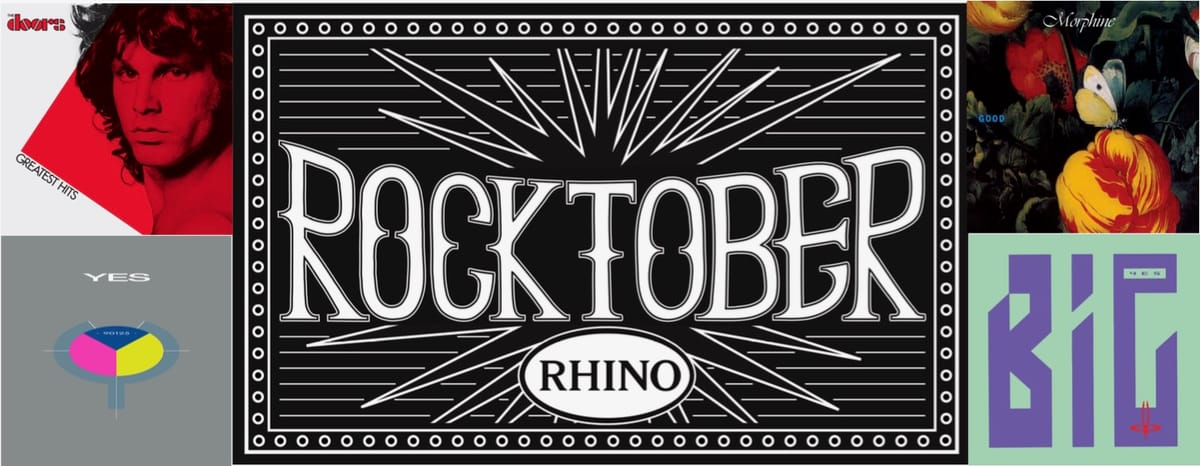
Vinyl reviews of the Doors' Greatest Hits, Yes's 90125 (both in Rhino Reserve pressings), Morphine's Good, and Yes's Big Generator.
By my count, 14* vinyl reissues from Warner labels are hitting the racks at independent record stores today (October 17), which means that Rhino's Rocktober has finally hit full speed. The monthlong campaign got off to a muted start—because of production delays, only three releases** came out during October’s first two Fridays. But now Rhino’s making up for lost time, with a busy schedule that will see somewhere in the neighborhood of 43 vinyl reissues out by month’s end.
*Actually, there may be 15 or 16. I'll explain in a bit.
**Those three are: Deep Purple's Live in Japan, remixed by Steven Wilson; a clear vinyl version of Never Mind the Bollocks, Here's the Sex Pistols; and a cobalt blue pressing of Fleetwood Mac's Tusk. We outlined those in past editions of our weekly New Releases post—be sure you're subscribed to The Vinyl Cut to get the latest.
To slightly complicate things—in a good way—some of this year’s Rocktober titles are also part of the Rhino Reserve series, the more affordable counterpart to Rhino’s premium Rhino High Fidelity series. If you’re unfamiliar, the Rhino Reserve series is pretty wonderful, with all-analog pressings of generally terrific albums, usually cut by Matt Lutthans and pressed at MoFi’s Fidelity Record Pressing in Oxnard, California. The handful of Rhino Reserves I’ve gotten my hands on have all sounded excellent, with near-flawless pressing quality, so you can be certain that the Rhino Reserve titles for Rocktober will be just as good. This is the first time there have been Rhino Reserve titles in the Rocktober mix, and they’re available either on the Rhino website or at your local. But all the other Rocktober releases need to be picked up at (or ordered directly from) a brick-and-mortar store—only fitting since Rhino Records itself got its start as an LA record store back in 1973.
Let’s take a look at what’s coming out today, Friday, October 17, 2025.
- Black Sabbath: We Sold Our Soul for Rock ’n’ Roll [translucent green vinyl]
- Death From Above 1979: You’re a Woman, I’m a Machine [pink splatter vinyl]
- The Distillers: Coral Fang [black splatter vinyl]
- The Doors: Greatest Hits [Rhino Reserve]
- Lenny Kravitz: Black and White America
- Morphine: Good [forest green vinyl]
- New York Dolls: ’Cause I Sez So [red vinyl]
- Porno for Pyros: self-titled [Rhino Reserve]
- David Lee Roth: The Warner Recordings 1985–1994
- Spain: The Blue Moods of Spain [blue vinyl]
- Type O Negative: The Least Worst of
- The Von Bondies: Pawn Shoppe Heart [Rhino Reserve]
- Yes: 90125 [Rhino Reserve]
- Yes: Big Generator [orange vinyl]
One or two additional titles may also turn up at your local record store. Those are Fleetwood Mac’s Bare Trees and Randy Newman’s Trouble in Paradise, both in Rhino Reserve editions. From what I can tell, the Randy Newman album is not technically part of the Rocktober 43, but it might get conveniently lumped in with everything else, because why not? And Bare Trees is showing up on some record stores’ new-releases lists for today, but I am working off of a press release from Rhino that states that it’s not due in stores until October 24. In any case, I’ll have a review of it in next Friday’s Rocktober newsletter, along with some more reviews. Both Bare Trees and Trouble in Paradise are available to order right now from Rhino’s website, in case you don’t feel like leaving the house.
Basically, the gist is: Lots of reissues. Some are on colored vinyl. Some are high-quality all-analog cuts. Go to your record store and look at ’em all. And to help you make your choices for what to bring home, I’ve got reviews for four of this week’s Rocktober records in this newsletter.
The Doors: Greatest Hits [Rhino Reserve]
(Please don’t be confused: Morphine’s 1995 album Yes is not included, and as far as I know, Yes has not yet released an album called Morphine, although the Doors probably wanted to.)
Check out the rest of The Vinyl Cut's Rocktober coverage here!
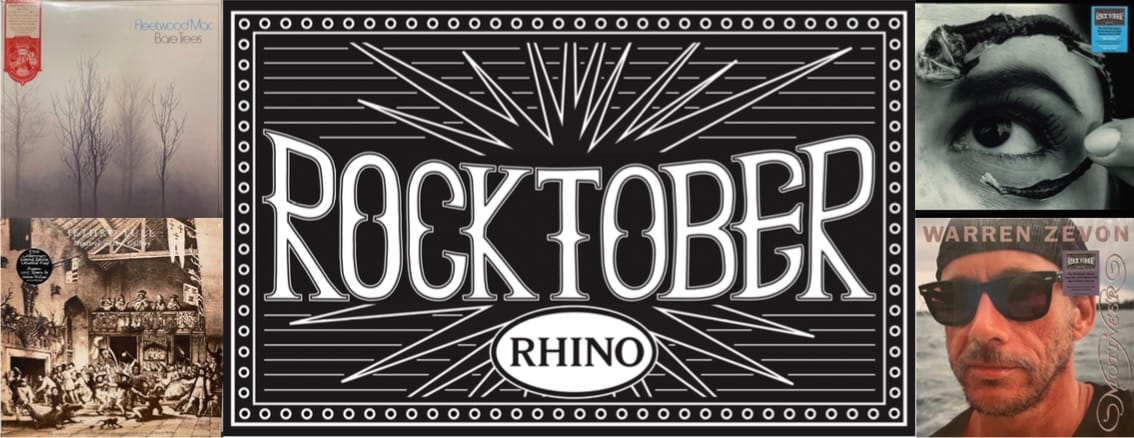
The Doors: Greatest Hits [Rhino Reserve]
It’s hard to get too nitpicky about the contents of the Doors’ Greatest Hits. Originally released in 1980, it wasn’t the first best-of album from the Doors, but it seems to have stood the test of time as one of the more enduring distillations of the Doors’ classic six albums. (For the purposes of this review, we can ignore the material the three remaining Doors released after singer Jim Morrison’s death in 1971.) In fact, if you swapped out “Not to Touch the Earth”—whose inclusion is nothing short of baffling—with “Love Her Madly,” an honest-to-god hit single that reached #11 on the Billboard charts, you’d have the perfect single-LP collection for casual Doors enthusiasts. I dunno, I guess they didn’t want to lean too heavily on L.A. Woman or something.
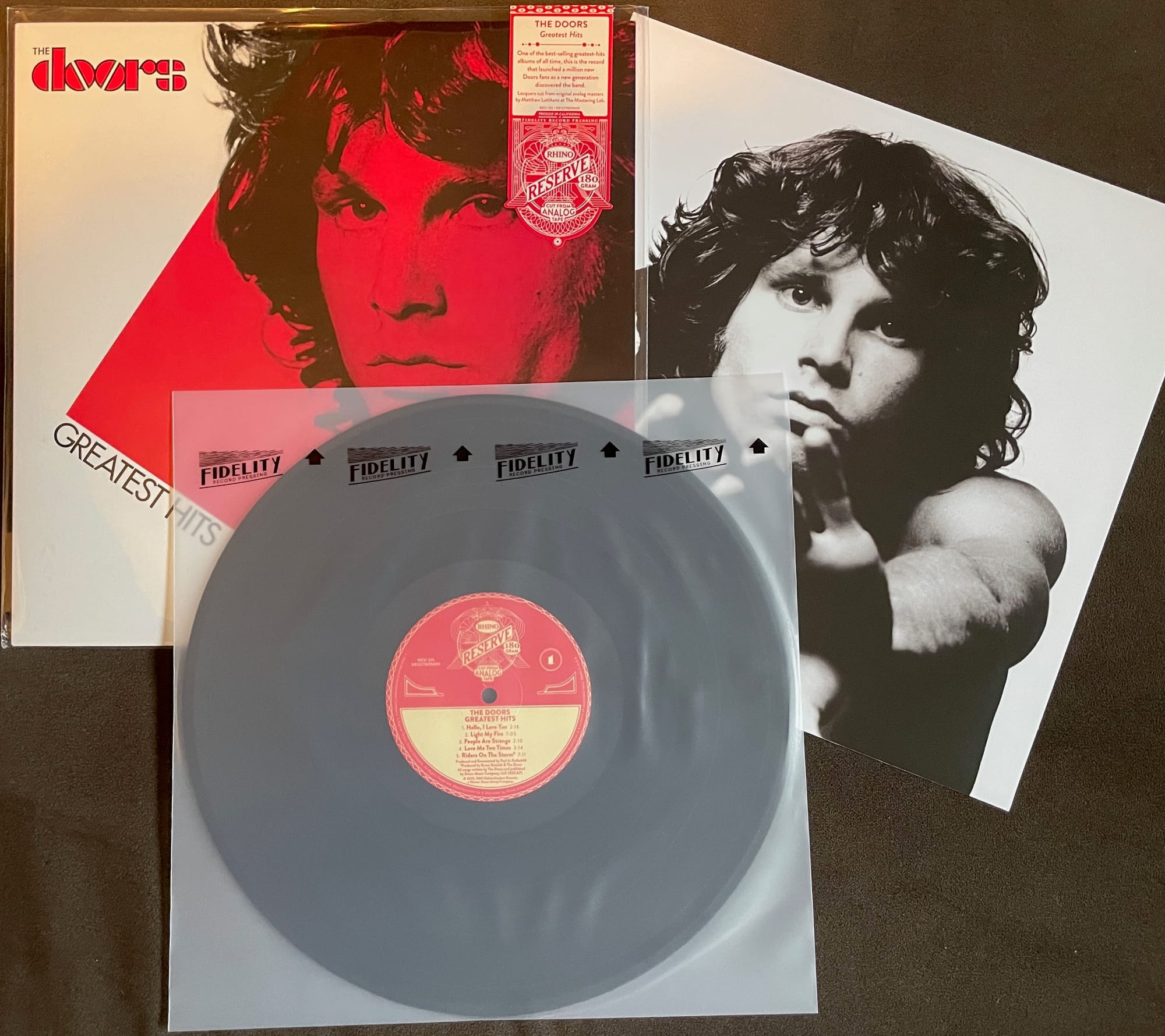
What’s a little easier to nitpick is the necessity of a high-quality, all-analog reissue of Greatest Hits, newly part of the premium Rhino Reserve line. Is this for hardcore fans who already know these songs by heart? Because vinyl-loving Doors fans with cash to burn have already had it pretty good. Analogue Productions did a 45 RPM series of the classic six albums back in 2012, and then repressed them in 2020; those versions are still in print. AP’s all-analog cuts could have been the final word on the subject of Doors vinyl, but last year Rhino High Fidelity did new all-analog cuts for a 6-LP, 33 RPM box set, with the individual titles receiving stand-alone releases separately earlier this year.
So this Rhino Reserve edition of Greatest Hits could be seen as putting a period on the end of that sentence. It’s cut from the analog master tape by Matt Lutthans at the Mastering Lab in Salina, Kansas. As far as what master tape, I imagine it’s the assembly reel that was put together when this particular compilation was prepared in 1980. That would mean that each track was copied onto a new reel from the album master, although it may not be as simple as that. It seems probable if not inevitable that the best-case scenario is that this disc was cut from second-generation dubs.
It doesn’t matter. True to form with previous Rhino Reserve releases, this new Greatest Hits sounds pretty terrific. I’ll admit that I’m coming to it without a huge background in great-sounding Doors vinyl—I don’t have any of the fancy Analogue Productions or Rhino High Fidelity editions. But I was able to compare two tracks from an original 1967 pressing of Strange Days, and the new edition has more precision, separation, and sturdier and more present bass. For example, “Love Me Two Times” on my 1967 Terre Haute pressing had plenty of excitement and liveliness but suffered significantly in the clarity department. I also compared “Break on Through” and “Light My Fire” with a 1971 Pitman press of The Doors, with similar results. The older pressing had a little bit more air, and more noticeable treble and breath present in the decay of each instrument, but the 2025 cut had more to offer, with instruments depicted in greater relief and a taming of the harsher edges. I could precisely hear each downward slide of Robbie Krieger’s fingers on the neckboard of his guitar in the main riff of “Break on Through,” not something I picked up on with the older pressing.
Elsewhere in the newer pressing, the rolling bass line in “Roadhouse Blues” possessed a pleasing, subliminal impact, and “Riders on the Storm” sounded as ominous and haunting as ever, with each instrument cleanly standing out in front of the rain sound effects that dominate the track and typically eat into the high end of any competing instruments, particularly the cymbals. I haven’t heard the track—my personal candidate for the Doors’ best—ever sound this transparent before, with every shimmer of Ray Manzarek’s Fender Rhodes audible and even a conga present in the mix that was heretofore undiscovered by me.
The 2025 Rhino Reserve reissue comes inside a plastic sleeve with a hype sticker that you need to rip in order to access the record inside; it’s the one thing I’m not a fan of with these Reserve titles. The inner sleeve is clear poly, accompanied by an empty paper inner sleeve that includes lyrics and a photo of Morrison—a slightly different configuration than the 1980 edition, which included an advertisement for the Doors’ LPs on the inner sleeve and a lyric sheet included separately. The vinyl, pressed at MoFi’s Fidelity plant, was flawless, flat, and perfectly centered and clean.
So who is this fancy new Greatest Hits for? As it turns out… me. And listeners like me who don’t own every Doors album and don’t particularly want to, but would like to have killer-sounding versions of their very best tracks, particularly “Riders on the Storm” and “Break on Through.” In that sense, the Rhino Reserve version delivers, even if I quibble with the comp’s slightly bizarre track order, which kicks off with “Love Me Two Times” and ends with “L.A. Woman,” when those should have been swapped by “Break on Through” and “Riders,” respectively.
And then there’s “Not to Touch the Earth.” What are you doing here, “Not to Touch the Earth”?
Rhino Reserve 1-LP 33 RPM • all-analog lacquer cut from the original master tape by Matt Lutthans of the Mastering Lab • pressed at Fidelity • black vinyl
Morphine: Good
If Morphine doesn’t sound incredible, it’s simply too early. The Boston-area band’s nocturnal music just doesn’t feel right to play during daylight hours—their minimal jazz-rock was based on a simple musical formula that never wore out during their too-brief lifespan, cut short by bassist/frontman Mark Sandman’s death in 1999. His two-string slide bass interacted perfectly with the baritone sax of Dana Colley, and his Beat-poet delivery kept on the cool, hushed end of the spectrum (with some notable exceptions). And with drums from either Jerome Deupree or Billy Conway—both play on Morphine’s 1992 debut Good—the formula was complete. That was it. No guitar. No keyboards. No top end, no backup singers, nothing except the deep, velvety morass that Sandman’s bass and Colley’s sax created.
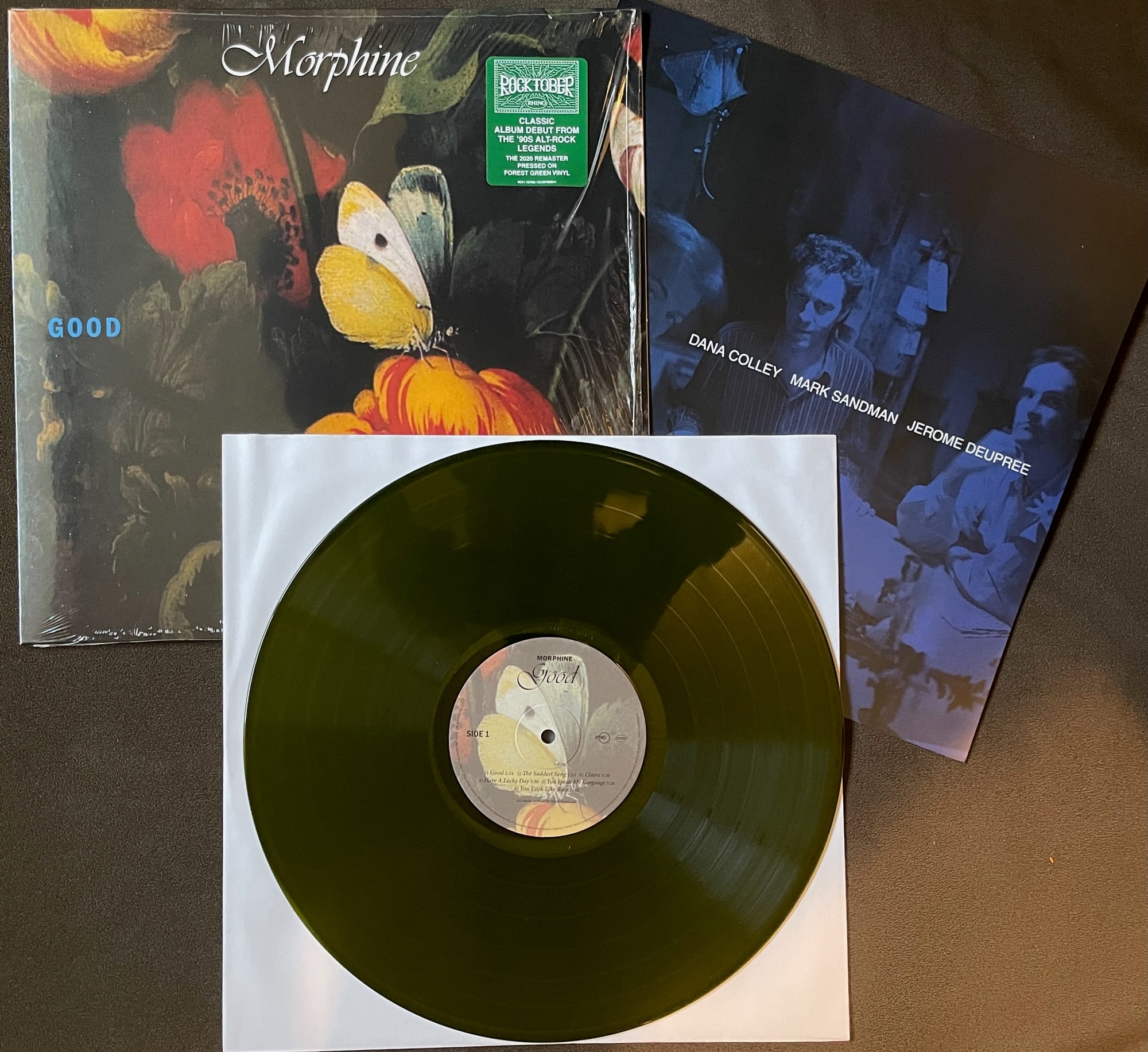
Good was originally released as a demo cassette by the band, then more properly released on CD and cassette on Accurate Distortion, a tiny Cambridge label. Rykodisc quickly picked the band up and gave Good wider distribution, but it never saw a vinyl release until well after Sandman’s death, in 2013 on Yep Roc. An expanded 2-LP edition came out on Run Out Groove in 2020, with mastering by Pete Weiss and a lacquer cut by Jeff Powell. Powell’s plates for the album are reused for Rhino’s Rocktober reissue, pressed on translucent forest green by GZ, although obviously the bonus disc is not included. (All the deadwax info from the earlier issue is visible—even the code from the previous pressing plant, Record Industry.)
This is, well, good. Weiss’s archival work and Powell’s lacquer resulted in the best presentation yet for Good. My ’90s Rykodisc CD is noticeably thin-sounding, with an exaggerated high end to compensate for Morphine’s inherently bass-heavy style, although that may have just been the Ryko house sound (owners of any of their David Bowie discs will know exactly what I’m talking about). The Run Out Groove version eliminated those issues, allowing the low-budget production to sound beefy and full while maintaining its smoky mystery, and providing a tonal roundness to Sandman’s patented bass in particular.
All of that carries over to the Rhino Rocktober release, which sounds terrific. Good is very much a debut album, finding the band climbing the up-ramp that would lead them to their masterpiece, 1993’s Cure for Pain. But already the band has grabbed ahold of their distinctly timeless sound, riding that low end down to Hades and back, not caring whether Eurydice is following them or not.
The package is pleasing, too, although the cover art looks pretty low-rez, perhaps unavoidably. There’s an insert with lyrics and credits, and the disc comes inside a polylined sleeve, hooray. My only problem comes from the pressing itself, done at GZ’s Memphis facility, with my particular copy playing with a bit of surface noise. It’s minor, so minor that I almost hesitate mentioning it, but hey, that’s what a review is for. When the music fully blossoms, it’s not an issue. But during the silence between songs and the quieter passages, it’s like trees rustling in the background—perhaps apt for the forest-green vinyl, but not an ideal Morphine listening experience.
However, as I mentioned, it’s an intermittent and tiny problem, and I’d much rather be with this album on vinyl than be without it. And I’d say the same goes for you, unless you already have access to the Run Out Groove double-LP from a few years ago—there were only 2925 copies made, so lucky you. Good is good enough that a little bit of, uh, extra atmosphere won’t rip you away from its narcotic pull.
Rhino 1-LP 33 RPM • mastered from the original source tapes by Pete Weiss • lacquer cut by Jeff Powell of Take Out Vinyl at Sam Phillips Recording Studio • plated at GZ Media, Czech • pressed at GZ’s Memphis Record Pressing • translucent forest-green vinyl
Yes: 90125 [Rhino Reserve]
The origin story of Yes’s 1983 album 90125 is too convoluted to go into much detail here. The short version is that Yes broke up in early 1981, then four former members teamed up with a new guy, Trevor Rabin, with a fifth former member, Trevor Horn, producing, and the intention of releasing an album under the name Cinema before discovering there already was a Cinema, and this was basically a Yes + Trevor Rabin album anyway, so why not just call it Yes? It ended up being their best-selling album, resulting in a number-one US single and a Grammy.
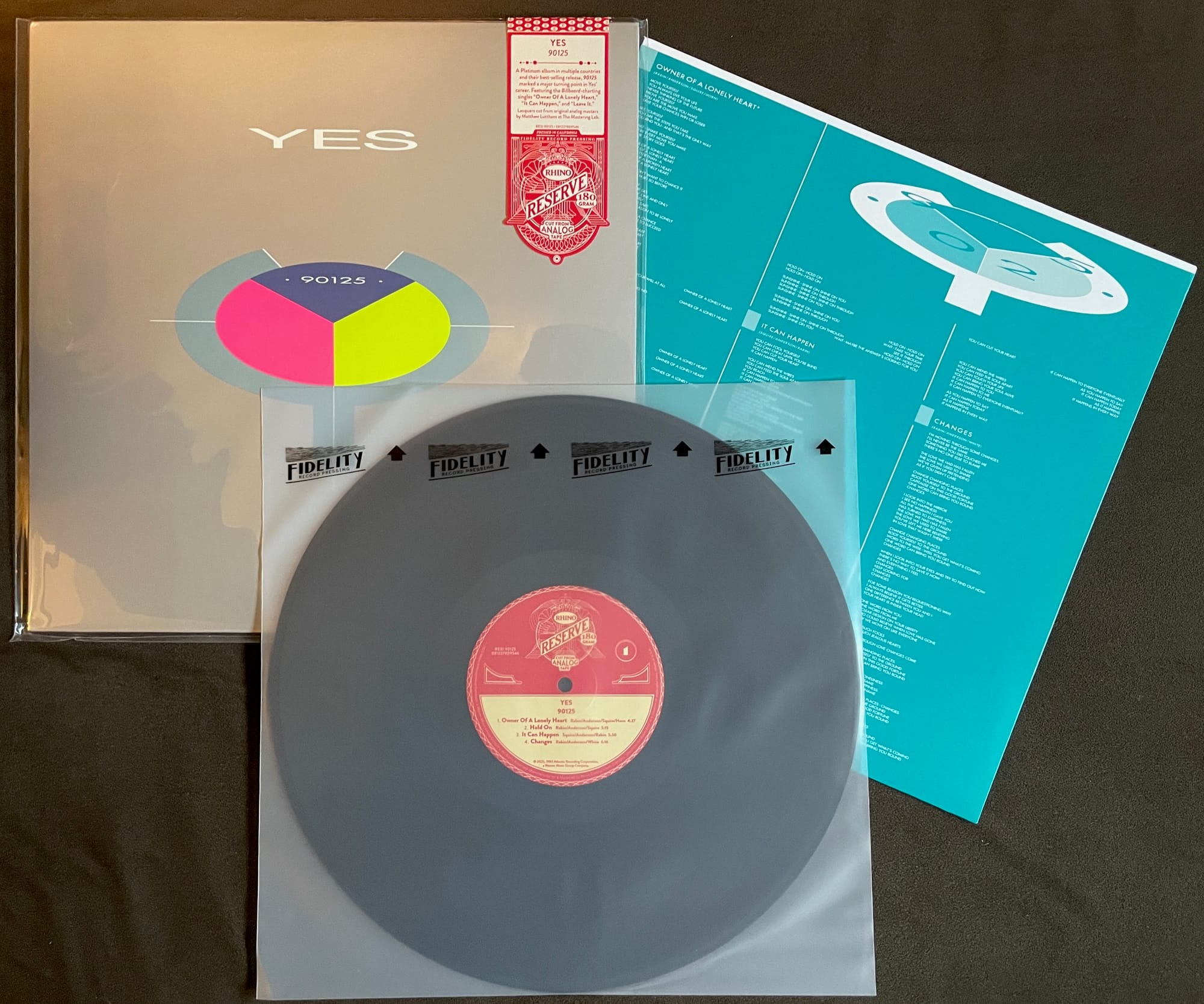
Rabin’s the dominant voice on 90125, making it a sharp but not altogether unwelcome departure from the genre-defining prog the English band was known for. Truth be told, Yes always possessed pop-songwriting smarts that they secretly deployed in the nooks and crannies of their multi-part suites, and conversely 90125 has prog flourishes leavening its bombastic FM-radio pop-rock (the tricky rhythms that open “Changes” being the most flagrant example).
This is just a massive-sounding album, with drums, guitars, synths, and overdubbed voices all contributing to the maximalist effect. There are elements that either presaged or directly influenced the rest of the ’80s, meaning that much of its impact is well-diluted more than 40 years later. But it must have sounded shockingly modern in 1983, and today some of it still does, even if other parts are risibly dated.
“Owner of a Lonely Heart” is the album in a nutshell, a ridiculously catchy track that to this day still inspires both wonderment and annoyance. With ultra-heavy guitars, breakbeats, synth-horn stabs, a silly guitar-harmonizer solo, and a rapturous Motown-style break, it holds a link to Yes’s past through Jon Anderson’s inimitable chirp but otherwise sounds like an entirely different band. Most of the special effects came from a Fairlight, but it’s shocking how well the song predicted where music production was headed, with many of its gimmicks becoming standard fare for hip-hop.
The rest of 90125 is less distinctive but consistently solid. From a production standpoint, the album is tougher to get one’s teeth into—or ears into, I should say. It’s very much of its time, with instruments heavily processed through noise gates, exciters, phasers, and all sorts of gizmos, resulting in an exhausting listen. My perception is that there’s a hard aural shell around all of it, something I find typical of a lot of early to mid-’80s recordings.
However, my original 1983 US pressing—cut at Masterdisk and pressed at Allied, and bearing Robert Ludwig’s famous initials on one side of the deadwax—makes the most of this, resulting in a cut that showed the state-of-the-art production in its best light. The record is punchy, bright, and full of vigor, with everything reaching a level of consistency that’s offset by perhaps a very, very faint veiling of sound.
The new Rhino Reserve version, cut by Matt Lutthans from 30 ips 1/2-inch tape, mitigates the ’80s sheen even further. It sounds more balanced and reserved, and it’s more gentle on the ears, but it seems a bit flat until you turn the volume up—then the album percolates with activity. The bass is clearer and deeper (I loved the subsonic vibrations I was able to feel during “It Can Happen”), and the different instrumental timbres are more individually perceptible, allowing you to pick them out of the wall of sound. Everything still sounds fully integrated—mimicking the strength of the Ludwig cut—but just a step more defined. If there is a slightly muted quality, it has to do with overall dynamics and not the clarity of sound. The near-invisible veil I perceive on the 1983 cut is not noticeable on the Rhino Reserve.
It’s a by-a-nose finish, though. Anyone with a clean original will likely be satisfied with what they have, unless they want a copy they can play at high volumes regularly, in which case the Rhino Reserve shines. One peculiarity is that on the new cut, “Our Song” does not fade in—it features a cold start. I can’t really account for that, except to note that “Does It Really Happen?” from Drama has a similar issue on different masterings; some feature a fade-in during the synth solo at around the five-minute mark, while others do not, and the mixes are otherwise the same. My best guess is that both Drama and 90125 featured some last-minute fade-in decisions during the mastering stage that aren’t reflected on the master tape. I’d be curious to know if the recent Analogue Productions 45 RPM version, cut by Kevin Gray, has the “Our Song” fade-in or not, since I imagine Gray used the same tape as Lutthans.
The sleeve has an appealing finish to the computer-gray artwork, with a replica of the original inner (the album itself comes in a poly sleeve). Again, the hype sticker that you have to tear through remains an annoyance, but the pressing—done at MoFi’s Fidelity plant—is excellent.
Rhino Reserve 1-LP 33 RPM • all-analog lacquer cut from the original master tape by Matt Lutthans at the Mastering Lab • pressed at Fidelity • black vinyl
Yes: Big Generator
Big Generator’s origin story is even more corporate and cynical than 90125’s, so much so that it could have laid the seeds for the punk movement had Tales from Topographic Oceans not already done so more than a decade prior. I’ll spare you the details, but the end result is a Yes album made by committee that no one was really satisfied with. It’s a noticeable step down from 90125, with a truly abominable title track and no real highlights among its eight songs. But the sheer expense that its recording must have incurred is audible in every song, and the experience and competence of the musicians shines out from between the synth-orchestra stabs and Van Halenesque guitar squeals.
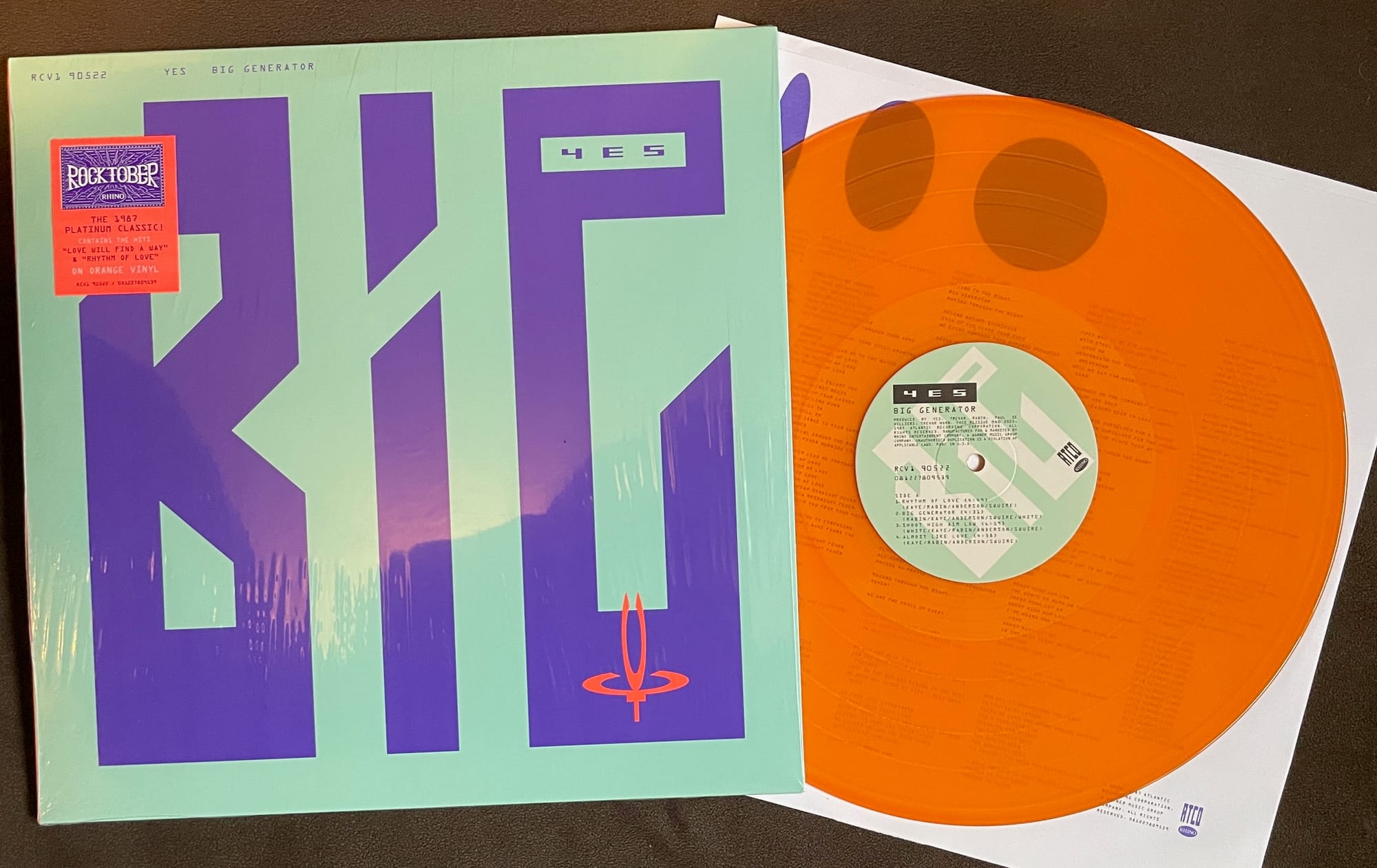
Because of its release date in 1987 and of the enormous scale of its production, I’m assuming that the Big Generator master is digital. That makes it easier to be indifferent to the pedigree of this new cut, which is the first vinyl treatment the album has received since its original issue, apart from a 2013 version on Friday Music. In fact, it’s impossible to tell how this new pressing was made, but it seems most likely that it’s from a high-resolution digital file sent to GZ and cut anonymously there. The deadwax on my copy bears the typical GZ code, as well as “MRP” for GZ’s Memphis facility, where American copies were pressed—I assume European copies were cut at GZ’s Czech plant. There are no other identifying marks. (A credit on the inner sleeve for Stephen Marcussen at Precision Lacquer is a vestigial remnant from the original 1987 pressing.)
It sounds fine. I don’t have an original to compare it to, but everything is clear and present and accounted for, and the dense production never turns into soup. The production is full of midrange and high end, with not very much going on in the deeper end of the sound spectrum. The translucent orange vinyl is more than adequate (I got two tiny scrapes of noise and some fuzz during the fadeout of the final track, but the disc was flat and perfectly centered). The sleeve is a full replica of the original, down to the paper inner sleeve—not polylined, unfortunately.
In fact, the whole package feels like a corporate product void of identity, from the anonymous cover art to the slick contents in the grooves. It’s a bit of a shame that Yes had already named their previous album after its catalog number—had they saved the idea for Big Generator, the notion of a mass-produced product subsuming the art contained within would have been even better realized. In that sense, an anonymous, unexceptional, but fully competent cut from GZ, the world’s biggest vinyl pressing company, suits this reissue perfectly.
Rhino 1-LP 33 RPM • anonymous lacquer cut from digital file at GZ Media, Czech • pressed at GZ’s Memphis Record Pressing • translucent orange vinyl
Listening equipment
Table: Technics SL-1200MK2
Cart: Audio-Technica VM540ML
Amp: Luxman L-509X
Speakers: ADS L980

